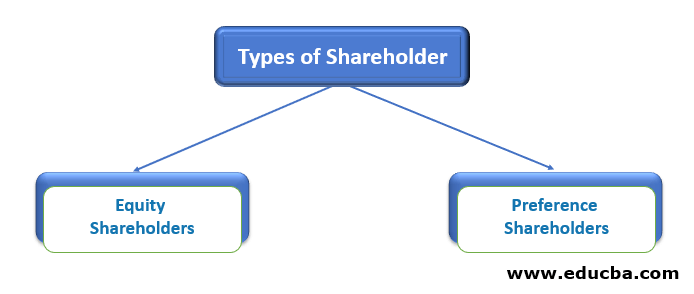Updated October 3, 2023
Introduction of Shareholder
Every company gathers finance through two sources – internal and external. Internal sources, i.e., company members, and external sources, such as financial institutions, banks, etc., in the form of loans. Over here, we will talk about the internal source i.e. the capital raised through members of a company.
Generally, any person becomes a company member by acquiring shares of the same. Now, what does a share mean? A company divides its capital into shares of various denominations. For example, if a company has a capital of Rs. 100,000/-, then it can be divided into 1000 shares of Rs. 100/- each (1000*100=100,000).
Types of Shareholder
There are two major types of shareholders: equity shareholders and preference shareholders. Both of them have their own specific rights and obligations towards the company.
1. Equity Shareholders
Equity Shareholders refer to those shareholders who actively participate in the important decisions of the company and also bear a greater risk as compared to other kinds of shareholders, which entails greater profits in case a company gains and suffers losses if the company does not fare well in business in a particular period.
Equity shareholders enjoy the following benefits:
- They get the right to participate in the major decisions taken by the company through voting.
- Preference shareholders have their liability limited to the value of the shares they hold.
- They possess the entitlement to receive dividends and a share of the profits generated by the company in which they have invested.
2. Preference Shareholders
Preference shareholders have limited decision-making powers in the company, but they hold a preferential right over the profits earned by the company, surpassing that of equity shareholders.
Preference shareholders enjoy the following benefits:
- They get preference at the time of payment of dividends.
- During the liquidation of a company, the dues of preference shareholders are given priority over those of other shareholders.
- In the case of cumulative preference shares, if a company fails to pay dividends in a specific year, the unpaid dividends accumulate and are carried forward to subsequent years.
The sub-types of Preference shareholders are mentioned below:
- Convertible and Non-Convertible Preference Shareholders: Convertible Preference shareholders have an option/right to convert their shares into equity shares after a certain period of fulfilling certain terms and conditions. However, Non-Convertible shareholders don’t possess any such rights.
- Redeemable and Irredeemable Preference Shareholders: A company must pay back the capital in case of Redeemable Preference shares, which consequently results in the discontinuation of payment of dividends(preferential right on such shares). In the case of Irredeemable Preference shares, the company pays dividend till it continues to exist and does not pay back the capital to such shareholders.
- Cumulative and Non-Cumulative Preference Shareholders: In a case where a company is not able to pay dividends to preference shareholders in case of lack of funds, it gets accumulated for the next financial year in case of Cumulative Preference Shareholders. On the contrary, Non-Cumulative Preference shareholders lose their right to receive dividends if a company fails to pay the same in a particular financial year.
- Participating and Non-Participating Preference Shareholders: Participating preference shareholders possess an additional right to participate in the decisions of the management of the company. In contrast, non-participating preference shareholders do not possess any such rights.
From the above discussion, we can conclude that there are two types of shareholders: Equity and Preference. Acquiring any of them has its own pros and cons. Equity shareholders get a right to participate in the decisions of the company. The downside of it is that they have to bear a higher risk and can also go on without even earning a penny if the company suffers losses in a particular financial year. On the other side, Preference shareholders play safe. They don’t get the right to participate in important business decisions. However, they get a definite percentage of profits no matter how the company fared in terms of profits and growth in a particular financial year.
Recommended Articles
This is a guide to Shareholder Types. Here, we also discuss the introduction and types of the shareholders, which include equity and preference shareholders. You may also have a look at the following articles to learn more –





